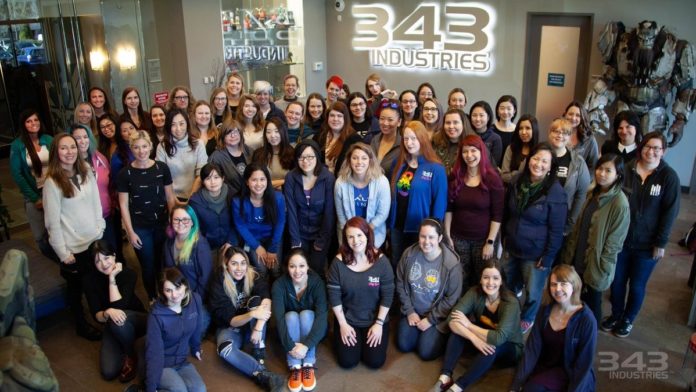By: Dylan Donlon, George Mason University Student
When you close your eyes and imagine the typical American “gamer,” what do you see? A high school-aged guy at his friend’s house for a Super Smash Bros. tournament? An avid 12-year-old Pokemon player?
Think again. In reality, the average gamer is more likely to be a careerwoman in her 30s. According to the Entertainment Software Association, the gaming population in America in 2018 was 45 percent female, but women still make up only 22 percent of the game industry. While these numbers are up significantly in the past 10 years, there is still a need for increased female representation in the professional sphere.
Enter Women in Gaming. This group of women in industry roles is turning the spotlight on the brilliant women involved in making some of the biggest titles in AAA gaming today. Formed by members of Microsoft’s Team Xbox, Women in Gaming (WiG) is a coalition of female professionals who celebrate the achievements of women from all across the game industry, from developers, designers, and software managers to PR and marketing strategists. Year-round, WiG highlights the accomplishments of female devs on their Twitter page. But what it’s best known for is its annual rally at the prominent Game Developers Conference (GDC) in San Francisco, California. Here, industry experts from all over the U.S. recognize the female faces behind our favorite games and share their experience and advice with future professionals aspiring to bring their talent to the game development world.
Following a hugely successful reception at GDC 2019, I interviewed WiG co-leader Nicole Fawcette, senior integrative marketing communication at Microsoft Xbox and senior brand manager for titles like Gears of War and Killer Instinct, on her experience as a game professional and her advice for future female voices in game development.
Tutorial: WiG Origins

According to Fawcette, Women in Gaming began 20 years ago as a casual meetup for drinks at the Electronic Entertainment Expo (E3), where its founders – Bonnie Ross, now corporate vice president at Microsoft Studios and head of 343 Studios (best known for the Halo franchise), Kiki Wolfkill, now executive producer at 343 Studios, and Shannon Loftis, now General Manager for Studios 1st Publishing – decided that each year, they would bring along a new female friend. Gradually, the group grew from a hangout to a formal luncheon, until eventually numbers began pushing more than 250 attendees. In what Fawcette called a “social group turned HR initiative,” the newly-formed WiG was a way for women at Team Xbox and their colleagues to find community in an industry that still lagged in representation.
Eventually, WiG took an indefinite hiatus. Fawcette recalls that even though she began working at Xbox five years ago, she didn’t hear about WiG’s existence until 2016, in the wake of backlash from Xbox’s infamous party at GDC, where the company was criticized for the presence of scantily-clad female dancers. To reaffirm its dedication to improving diversity and representation in games, Team Xbox revived WiG with a promise to do better – and do better it did. Taking the former luncheon to a rally format at GDC, over 600 female game professionals from all over the States now attend the yearly event, where aspiring members of the industry can hear inspirational stories and even meet WiG’s guests one-on-one.
Xbox also turned its focus to its Gaming for Everyone program, a network of diverse groups in game development highlighted on Xbox’s website. “We don’t want to call it an initiative,” said Fawcette. “It’s more of an outward expression of internal values. At Xbox, we have the internal value that gaming is for everyone, so we want to get everyone involved and excited.” With teams like LGBTQI+ in Gaming, Women in Gaming, Blacks in Gaming, Latinx in Gaming, and many others represented, Xbox hopes to bring “intentional, inclusive practices and thinking” to the industry. Fawcette emphasized the importance of publicly acknowledging these diverse professional groups. “Internally you can have these values, sure – but you don’t get anywhere without making a statement outwardly,” she said. “By bringing awareness and having these conversations, it makes everybody look inside and say, ‘We want to create a place where we can not only make games for everyone, but also a place where everyone can make games.’”
Level Up: A Changing Playing Field
The game industry has indeed evolved since Fawcette began working in it. She cited the change in the attitude around women’s participation as the biggest improvement. “The industry knows it needs more women, and it’s much more open to that now,” she said. “There’s no longer a sense of incredulousness for women to say they want to work in game design.” She was inspired by groups like Girls Make Games, which showed her that more people are wanting to learn and lending more visibility to the myriad of roles that one can have in the game development process. “Designer, narrative designer, user interface, programming – these weren’t talked about and I didn’t even know they existed. It’s just kind of funny, you don’t even know what’s out there. But initiatives like these show that there’s been an improvement in diversity in roles.”
Easter Egg: Women Made What?
Most people are unaware of the role women play in game creation. According to Fawcette, the games you think of as “for men,” such as big first-person shooters like Halo, are actually primarily run by women. Fawcette explained that it can be difficult to browse gaming forums and see the way some male gamers often deride women. “When you see things online, you try not to let it get you down. But sometimes I just wanna yell, ‘Did you know that most of what you love has come from women’s work?!’” She emphasized the importance of initiatives like WiG to show the real women who put their effort and passion into making games. “It’s a very vocal consumer base with a lot of misinformation on how games are made. Demystifying the process behind games is always a great thing, so you can see the real people who brought the game to life.”
Upgrade: The Future is Female
In the next 10 years, Fawcette is hopeful that the “50/50 goal” will come to fruition and the industry will finally reflect the audience. “This sounds awful, but I would love for there not to be a Women in Gaming – to not be required to have a separate initiative to shore up on marginalized groups,” said Fawcette. She recalled seeing many internet trolls claiming that there’s “no need” for a Women in Gaming in the first place, but admitted that in the current climate, we just aren’t far enough along in representation progress to do without it. “‘It shouldn’t matter who’s hired if they’re best for the job,’ they’ll say. Sure, ideally – but in reality, there are so many different things about the female experience. That just isn’t realistic,” she said.
Fawcette is most inspired by the new games she sees coming out from women-led studios, especially independent studios. “Games are rich, emotional and beautiful, and some of the best games I’ve played in the past year and a half have been created by indie team without much recognition,” she said. She hopes that games like these will “open the floodgates” to much more content created by women coming to the forefront in the future.
Epilogue: Advice for the Aspiring Developer
With an increasing number of U.S. higher education institutions offering major and minor programs for game design, many students are now pursuing formal degrees. Fawcette has some advice to aspiring members of the game industry.
“Keep making games and doing what you want to do,” she said. “You don’t need to wait; in fact, you have to already be doing it before you get a job to make it in the industry.” Fawcette recalled her own experience climbing the game industry ladder from a marketing standpoint. She began as an unpaid reviewer for games in a local magazine. “I got all the crappy games, but it gave me a chance to start networking. I learned how to review and storytell games, too; without doing that I don’t think I would have gotten into the industry.” She encourages students to build their portfolios as much as possible while still in school, and to create independently on their own time as well.
“If you have an idea, write it down. If you want to do music, make a SoundCloud. If you want to write, make a blog and get it out there. That’s the best way to start and keep your passion lit while you figure out what you need skills-wise to apply that passion to jobs. Showing you’re already doing stuff is huge.”










